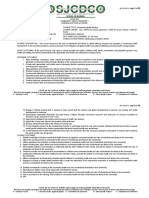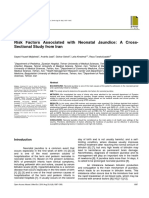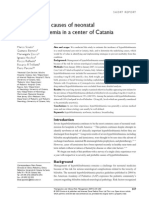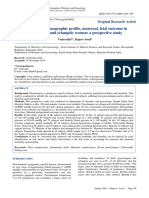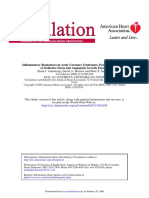Hypoglycemia in Exclusively Breastfed High-Risk Neonates - A Hospital-Based Study
Hypoglycemia in Exclusively Breastfed High-Risk Neonates - A Hospital-Based Study
Uploaded by
Neta Aza MaineztCopyright:
Available Formats
Hypoglycemia in Exclusively Breastfed High-Risk Neonates - A Hospital-Based Study
Hypoglycemia in Exclusively Breastfed High-Risk Neonates - A Hospital-Based Study
Uploaded by
Neta Aza MaineztCopyright
Available Formats
Share this document
Did you find this document useful?
Is this content inappropriate?
Copyright:
Available Formats
Hypoglycemia in Exclusively Breastfed High-Risk Neonates - A Hospital-Based Study
Hypoglycemia in Exclusively Breastfed High-Risk Neonates - A Hospital-Based Study
Uploaded by
Neta Aza MaineztCopyright:
Available Formats
ISSN: 2469-5769
Patel et al. Int J Pediatr Res 2020, 6:066
DOI: 10.23937/2469-5769/1510066
Volume 6 | Issue 2
International Journal of Open Access
Pediatric Research
Original Research
Hypoglycemia in Exclusively Breastfed High-Risk Neonates
- A Hospital-Based Study
Parth Patel*, Palash R Gogoi, Santanu Deb, Prasenjit Paul, Sabrina Yesmin, Lima Sangla
Jamir and Pramod Paharia Check for
updates
Department of Pediatrics, Nazareth Hospital, Shillong, Meghalaya, India
*Corresponding author: Dr. Parth Patel, Department of Pediatrics, Room no. 1, Above Private B, Nazareth Hospital,
Laitumkhrah, Shillong, Meghalaya - 793003, India
Abstract Conclusion: We conclude that the incidence of asymptom-
atic hypoglycemia is fairly common in high-risk neonates.
Background: Hypoglycemia is one of the commonest met- Strict monitoring and a close watch are therefore necessary
abolic problems in contemporary neonatal medicine. In the to detect hypoglycemia and institute measures to prevent
majority of healthy neonates, the frequently observed low progression to symptomatic hypoglycemia and sequelae
blood glucose concentrations are not related to any signif- later on in life.
icant problem and merely reflect normal processes of met-
abolic adaptation to extrauterine life. However, when low Keywords
blood glucose levels are prolonged or recurrent, they may
Hypoglycemia, Newborns, Incidence, Risk factors
result in acute systemic effects and may result in neurologic
sequelae.
Aims and Objectives: To find out the incidence of hypo- Introduction
glycemia in exclusively breastfed high-risk newborns and to
study associated risk factors like gender, gestational age,
Hypoglycemia is one of the commonest metabolic
birth weight, time of onset of the development of hypogly- problems in contemporary neonatal medicine. In the
cemia majority of healthy neonates, the frequently observed
Methodology: This Descriptive Cross-sectional study of low blood glucose concentrations are not related to any
neonates enrolled 75 exclusively breastfed high-risk neo- significant problem and merely reflect normal process-
nates (low birth weight, late preterms, small-for-gestation, es of metabolic adaptation to extrauterine life. How-
large-for-gestation, infant of diabetic mother and macro- ever, when low blood glucose levels are prolonged or
somic), who did not require admission to neonatal intensive
care unit and were kept in postnatal wards with mother. Hy-
recurrent, they may result in acute systemic effects and
poglycemia was defined as blood glucose < 40 mg/dl. Blood neurologic sequelae [1]. The fetus in utero is entirely de-
glucose was monitored until 72 hours of life (at 2, 6, 12, 24, pendent on the mother for glucose. At the time of birth,
48, 72 hrs of life). the neonate must abruptly switch from having a con-
Results: The incidence of hypoglycemia in newborns with tinuous supply of glucose from the maternal blood in
risk factors was 20% (15 of 75 neonates). All were asymp- fetal life to maintaining its own supply of glucose during
tomatic. The incidence of hypoglycemia in SGA neonate periods of fasting, and when feedings are interspersed
was 37.5% (6/16), in LGA neonate was 18% (2/11), in
Macrosomic neonates 20% (2/10), in LBW neonates 24% intermittently [2]. Postnatal hypoglycemia in newborn
(9/38), in IDM was 14% (4/25) and in late preterm was 14% infants remains an important clinical problem and pro-
(2/12).In the present study, most of the neonates had hypo- longed periods of hypoglycemia may be associated with
glycemia within 24 hours of life and none of the neonates poor neurodevelopmental outcomes. Since prolonged
were hypoglycemic after 48 hours of life.
periods of low plasma glucose are associated with in-
creased risk of neurodevelopmental impairment, it is
Citation: Patel P, Gogoi PR, Deb S, Paul P, Yesmin S, et al. (2020) Hypoglycemia in Exclusively Breast-
fed High-Risk Neonates - A Hospital-Based Study. Int J Pediatr Res 6:066. doi.org/10.23937/2469-
5769/1510066
Accepted: July 14, 2020: Published: July 16, 2020
Copyright: © 2020 Patel P, et al. This is an open-access article distributed under the terms of the
Creative Commons Attribution License, which permits unrestricted use, distribution, and reproduction
in any medium, provided the original author and source are credited.
Patel et al. Int J Pediatr Res 2020, 6:066 • Page 1 of 7 •
DOI: 10.23937/2469-5769/1510066 ISSN: 2469-5769
an important priority to prevent hypoglycemia in new- al age (SGA) infants (birth weight less or equal to the
born infants [3]. Certain risk groups, including small for 10th percentile for gestational age), large for gestation-
gestational age infants, preterm infants, and infants of al age (LGA) infants (birth weight more or equal to the
diabetic mothers, are at high risk of hypoglycaemia [4]. 90th percentile for gestational age), low-birth-weight ba-
Prevention, early diagnosis, and prompt treatment are bies (birth weight less than 2500 g), macrosomic infants
important for high-risk infants who develop hypogly- (birth weight more than 4000 g), infant of a diabetic
cemia, to minimize the severity and duration of hypo- mother (IDM) (maternal type 1 or type 2 diabetes melli-
glycaemic episodes, which are associated with adverse tus or gestational diabetes mellitus), late preterm infant
outcomes [5]. This study aimed to find out the incidence (LPI) (a premature infant born between 34-36 6/7 gesta-
of hypoglycemia in exclusively breastfed, high-risk new- tional week). The birth weight percentiles were adopted
borns, and to study associated risk factors like gender, from the Lubchenco chart [6]. Newborns with a major
gestational age, birth weight, time of onset of the devel- congenital malformation in whom breastfeeding cannot
opment of hypoglycemia. be initiated, who required I.V. fluid, in whom exclusive
Materials and Methods breastfeeding cannot be continued or contraindicated
were excluded. The detailed history of the enrolled ba-
This Cross-sectional, descriptive hospital-based study bies was taken which included various maternal risk fac-
was carried out in the Postnatal ward of Nazareth hospi- tors like GDM, PIH, twin pregnancy, etc, and neonatal
tal, Shillong from 15th January 2019 to 14th July 2019. A risk factors like prematurity, LBW, SGA, etc.
total of 75 newborns were included in the study. Ethical
clearance for conducting the study was obtained from Capillary blood samples were taken after warming
the institutional ethics committee. We included all high- the heels of the babies. Blood glucose concentration
risk healthy newborns who were exclusively breastfed was determined by using the glucometer and test strips
after obtaining informed consent from the mother. (SD CodeFree, SD BIOSENSOR). Capillary blood sugar
The high-risk group was defined as small for gestation- was checked with a portable glucometer at 2 hours, 6
Table 1: Demographic data of the enrolled neonates and their mothers.
N = 75 Number of cases Percentage of cases
Sex Male 33 44%
Female 42 56%
Residence Urban 41 54.7%
Rural 34 45.3%
Religion Hindu 21 28.0%
Christian 51 68.0%
Muslim 3 4.0%
Other 0 0.0%
Antenatal History Booked 46 61.3%
Unbooked 29 38.7%
Obstetric History Primigravida 19 25.3%
Multigravida 56 74.7%
Maternal Age < 30 Years 31 41%
> 30 Years 44 59%
Maternal History Nil 31 41.3%
GDM 26 34.7%
DM 3 4.0%
PIH 5 6.7%
Hypothyroidism 4 5.3%
PROM 3 4.0%
Other 3 4.0%
Mode of Delivery Nvd 21 28.0%
Forceps 2 2.7%
Vacuum 1 1.3%
Elective CS 12 16.0%
Emergency CS 39 52.0%
Patel et al. Int J Pediatr Res 2020, 6:066 • Page 2 of 7 •
DOI: 10.23937/2469-5769/1510066 ISSN: 2469-5769
hours, 12 hours, 24 hours, 48 hours, and 72 hours of life mothers had a higher incidence of hypoglycemia than
and recorded. The babies were observed for signs and those of primigravida mothers. Hypoglycemia was
symptoms attributable to hypoglycemia. Hypoglycemia found to be more in newborns whose mother’s age was
definition that was used in the study was blood glucose > 30 years than in newborns whose mother’s age was <
level below 40 mg/dl [7]. 30 years at the time of delivery and higher in neonates
who were delivered through cesarean section than the
Following the detection of hypoglycemia, the neo-
vaginal route. These observations were found to be sta-
nates were managed as per institutional protocol. p-val-
tistically significant after applying the tests of propor-
ue < 0.05 was considered statistically significant.
tion Table 3.
Results In the present study, out of 38 LBW neonates 24%
During the study period, a total of 758 deliveries oc- (9/38) neonates were hypoglycemic, which was found
curred. Overall 683 cases were excluded from the study: to be statistically significant. (Proportion test, p-value:
502 newborns because of being non-high-risk; 5 new- 0.004). Out of 29 IDM 14% (4/29) neonates were hypo-
borns for having major congenital malformation; 173 glycemic, which was found to be statistically significant.
newborns required I.V fluid; 3 newborns in whom exclu- (Proportion test, p-value: 0.001). Out of 14 Late preterm
sive breastfeeding could not be continued. The popula- neonates 14% (2/14) neonates were hypoglycemic,
tion demographics are depicted in Table 1 and Figure 1. which was found to be statistically significant. (Propor-
Of the 75 high-risk neonates that were enrolled in tion test, p-value: 0.02) Table 4.
this study, 15 neonates developed hypoglycemia in the In the present study, after analyzing the distribution
first 72 hours of life. So, the incidence of hypoglycemia of hypoglycemia and birth weight of the neonates, it
in the high-risk newborns is found to be 20% in this was found that amongst the 38 low birth weight new-
study Table 2. borns, 23.7% (9/38) were hypoglycemic. (Proportion
In the present study, the neonates of multigravida test, p: 0.004). Out of 27 normal birth weight neonates,
Total deliveries during the present study
period: 758
Excluded from the present study
based on exclusion criteria
N=683
Declined to participate/ Not fulfilled inclusion
refused consent : criteria (Non high-risk
N=0 neonates : 502
Newborns with major
congenital
malformation : 5
Newborns requiring
I.V. fluid : 173
Total cases enrolled in the
Newborns in whom
present study:
exclusive breastfeeding
N = 75
cannot be continued : 3
Hypoglycemic Non – Hypoglycemic
15 60
(20%) (80%)
Figure 1: Flow diagram of the distribution of cases in the present study.
Patel et al. Int J Pediatr Res 2020, 6:066 • Page 3 of 7 •
DOI: 10.23937/2469-5769/1510066 ISSN: 2469-5769
Table 2: Characteristics of high-risk neonates that were enrolled in the present study.
N = 75 Number of cases Percentage of cases
SGA 16 21.3%
LGA 11 14.7%
MACROSOMIC 10 13.3%
Inclusion Criteria LBW 38 50.7%
IDM 29 38.7%
Late Preterm 14 18.7%
Birth Weight LBW 38 50.7%
( Birth weight : < 2500 gm)
Normal Birth Weight 27 36%
( Birth weight : 2500-3999 gm)
MACROSOMIC 10 13.3%
( Birth weight : > 4000 gm)
Gestational Age Late Preterm - 14 18.7%
34 wk to 36 wk 6 days
Early term - 31 41.3%
37 wk to 38 wk 6 days
Full-term - 28 37.3%
39 wk to 40 wk 6 days
Late-term - 1 1.3%
41 wk to 41 wk 6 days
Post-term - 1 1.3%
42 wks and beyond
Table 3: Characteristics of the hypoglycemic neonates (n = 15).
N = 15 Number Incidence p-value
Sex Male 9 60% 0.45
Female 6 40%
Residence Urban 7 47% 0.8
Rural 8 53%
Religion Hindu 4 27% 0.1
Christian 11 73%
Muslim 0 0%
Other - -
Antenatal History Booked 4 27% 0.1
Unbooked 11 73%
Obstetric History Primigravida 3 20% 0.04
Multigravida 12 80%
Maternal Age < 30 Years 3 20% 0.04
> 30 Years 12 80%
Mode of Delivery Vaginal Route 3 20% 0.04
Cesarean Section 12 80%
14.8% (4/27) were hypoglycemic. (Proportion test, p: gestational age, it was observed that among the 14
0.002). Whereas in Macrosomic newborns we did not Late preterm newborns, 14.3% (2/14) were hypoglyce-
see a statistically significant difference. (Proportion test, mic, which was statistically significant. (Proportion test,
p: 0.1) Table 5. p: 0.03). Out of 31 Early term neonates, 22.6% (7/31)
were hypoglycemic, which was statistically significant.
On analysis of the hypoglycemic neonates and their
Patel et al. Int J Pediatr Res 2020, 6:066 • Page 4 of 7 •
DOI: 10.23937/2469-5769/1510066 ISSN: 2469-5769
Table 4: Distribution of hypoglycemia in the high-risk neonates in the present study (n = 75).
HIGH-RISK NEONATES HYPOGLYCEMIA ABSENT HYPOGLYCEMIA PRESENT p-value
(N = 75) Number of Percentage of Number of Percentage of
newborns newborns newborns newborns
SGA (N = 16) 10 62.5% 6 37.5% 0.33
LGA (N = 11) 9 82% 2 18% 0.07
MACROSOMIC (N = 10) 8 80% 2 20% 0.1
LBW (N = 38) 29 76% 9 24% 0.004
IDM (N = 29) 25 86% 4 14% 0.001
Late Preterm (N = 14) 12 86% 2 14% 0.02
Table 5: Distribution of hypoglycemia in the present study according to birth weight of the neonates (n = 75).
BIRTH WEIGHT HYPOGLYCEMIA ABSENT HYPOGLYCEMIA p-value
(N=75) PRESENT
Number of Percentage of Number of Percentage of
newborns newborns newborns newborns
Low Birth Weight (N = 38) 29 76.3% 9 23.7% 0.004
Normal Birth Weight (N = 27) 23 85.2% 4 14.8% 0.002
MACROSOMIC (N = 10) 8 80% 2 20% 0.1
Table 6: Distribution of Hypoglycemia in the present study according to gestational age of neoantes (N = 75).
Gestational Age Hypoglycemia Absent Hypoglycemia Present p-value
(N = 75) Number of Percentage of Number of Percentage of
newborns newborns newborns newborns
Late Preterm - 34 Wk To 36 12 85.7 % 2 14.3% 0.03
Wk 6 Days
(N = 14)
Early Term - 37 Wk To 38 Wk 24 77.4% 7 22.6% 0.007
6 Days
(N = 31)
Full-Term - 39 Wk To 40 Wk 23 82.1% 5 17.9% 0.004
6 Days
(N = 28)
Late-Term - 41 Wk To 41 Wk 1 100% 0 0% --
6 Days
(N = 1)
Post-Term - 42 Wks And 0 0% 1 100% --
Beyond
(N = 1)
(Proportion test, p 0.007). Among the 28 Full-term new- hours vs. > 24 hours of life). This further reinforces the
borns 17.9% (5/28) were hypoglycemic, which was sta- fact that proper monitoring of blood glucose is highly
tistically significant. (Proportion test, p 0.004) Table 6. essential for the first 24 hrs of life Figure 2.
Out of 15 newborns who developed hypoglycemia, The authors of this study did not find any neonate
all except one neonate developed hypoglycemia by 24 with symptomatic hypoglycemia. None of the neonates
hrs of age: 26.7% (4/15) neonates had hypoglycemia required IV fluid therapy or NICU admission following
at 2 hours of life, 40% (6/15) neonates had hypoglyce- the development of hypoglycemia. All were managed
mia at 6 hours of life, 20% (3/15) neonates had hypo- with frequent breastfeeding as per institutional policy.
glycemia at 12 hours of life, 6.7% (1/15) neonate had
hypoglycemia at 24 hours of life, 6.7% (1/15) neonate
Discussion
had hypoglycemia in at 48 hours of life and none had In the present study, out of 75 newborns, 15 new-
hypoglycemia at 72 hours of life. This observation was borns were found to be hypoglycemic whereas 60 new-
found to be statistically significant (p-value: 0.01 - 1st 24 borns did not have hypoglycemia. Hence the incidence
Patel et al. Int J Pediatr Res 2020, 6:066 • Page 5 of 7 •
DOI: 10.23937/2469-5769/1510066 ISSN: 2469-5769
Figure 2: Detection of hypoglycemia in hours of life in newborns in the present study (n = 75).
Table 7: Various studies have shown a varying incidence of hypoglycemia.
Sr No. Authors Year Place Incidence of hypoglycemia
1 Present study 2019 Meghalaya, India 20%
2 Harris DL, et al. [4] 2012 Auckland, New Zealand 51%
3 Turner D, et al. [8] 2019 Boston, MA, USA 40%
4 Kumar TJ, et al. [9] 2018 Chennai, India 33.3%
5 Saini A, et al. [10] 2018 Haryana, India 24%
6 Mehta YP, et al. [11] 2017 Maharastra, India 22%
7 Atrushi AM, et al. [12] 2016 Duhok, Iraq 17.8%
8 Zhou W, et al. [13] 2015 Shanghai, China 16.9%
9 Kanagagiri R, et al. [14] 2018 Imphal, India 16.5%
10 Singh YP, et al. [15] 2014 Imphal, India 15.20%
11 Das A, et al. [16] 2019 Jharkhand, India 8.63%
12 Bromiker R, et al. [17] 2017 Jerusalem, Israel 3.4%
of hypoglycemia in exclusively breastfed but high-risk In our study, the incidence of hypoglycemia in male
neonates was 20% (Table 7). neonates was found to be more than female neonates
(27.3 vs. 14.3%). However, when the incidence of hypo-
Various researchers have used different definitions
glycemia was compared with each other it was conclud-
of hypoglycemia, a variety of methods of detection of
ed that hypoglycemia in exclusively breastfed high-risk
hypoglycemia and their studies have used different in-
newborns, did not have any sex predilection (p: 0.45).
clusion and exclusion criteria for their studies. Hence we
This observation was similar to the studies conducted
see a wide variation in the incidence figures. Population
by Saini A, et al. [10] from Haryana, India in the year
characteristics may also have led to variation in the fig-
2018, and a study conducted by Jonas D, et al. [20] from
ures of incidence.
Feldkirch, Austria the year 2014.
The relatively high incidence of hypoglycemia in this
We found that the incidence of hypoglycemia in
study amongst exclusively breastfed high-risk neonates
newborns was higher when maternal age was more
born in a tertiary care hospital in Meghalaya could be
than ≥ 30 years, but the results were different from the
attributed to certain population characteristics such as
study conducted by Kumar TJ, et al. [9] in the year 2018,
the high prevalence of multiparity and elderly gravidae.
where they found that the incidence of hypoglycemia in
Meghalaya has a TFR 3 (NFHS 4 data) [18] which is the
infants born to mothers less than 30 years of age was
second-highest in the country and much higher than
38%, while the incidence in infants born to ≥ 30 years
the national average of 2.2 [19]. This would have a cas-
was 18.9%. In our study, the enrolled subjects that were
cading effect and lead to preterm births, late preterm
more than 30 years usually had multiparity and poor
births, and the birth of low birth weight neonates. This
maternal health and had poor access to medical ser-
study also enrolled a relatively high number of Infants of
vices.
diabetic mothers which is a reflection of the high preva-
lence of diabetes in the population. In our study, the neonates of multigravida mothers
Patel et al. Int J Pediatr Res 2020, 6:066 • Page 6 of 7 •
DOI: 10.23937/2469-5769/1510066 ISSN: 2469-5769
had a higher incidence of hypoglycemia than primigrav- newborn infants with gestational age ≥ 35 weeks. Acta Pae-
idae. Similar results were obtained by Sasidharan CK, et diatr 109: 31-44.
al. [21]. But result was different in the study which was 4. Harris DL, Weston PJ, Harding JE (2012) Incidence of neo-
conducted by Purnima Samayam, et al. [22] in the year natal hypoglycemia in babies identified as at risk. J Pediatr
161: 787-791.
2015 where they found 23.07% of neonates born to
primiparous mothers had hypoglycemia, against 5.4% 5. Kaiser JR, Bai S, Gibson N, Holland G, Lin TM, et al. (2015)
Association between transient newborn hypoglycemia
neonates born to multiparous mothers. This finding can
and fourth-grade achievement test proficiency: A popula-
also be explained by the advanced age of the mothers tion-based study. JAMA Pediatr 169: 913-921.
(above 30 years) with poor maternal health and access
6. Lubchenco LO, Hansman C, Dressler M, Boyd E (1963)
to maternal health services in the multiparous mothers. Intrauterine growth as estimated. Pediatrics 32: 793-800.
The infants who were delivered by cesarean section 7. Jr WWH, Raju TNK, Higgins RD, Mbbs SCK, Devaskar
were found to be at higher risk for developing hypo- SU (2009) Knowledge gaps and research needs for under-
glycemia in our study (p-value: 0.04). Potential mech- standing and treating neonatal hypoglycemia: Workshop
report from eunice kennedy shriver national institute of child
anisms that might mediate this association include de-
health and human development. J Pediatr 155: 612-617.
layed lactogenesis, delayed skin-to-skin, and impaired
thermoregulation 8. Turner D, Monthé-Drèze C, Cherkerzian S, Gregory K, Sen
S (2019) Maternal obesity and cesarean section delivery:
Conclusion additional risk factors for neonatal hypoglycemia? J Perina-
tol 39: 1057-1064.
The present study has shown that the incidence of 9. Kumar TJ, Vaideeswaran M. AST (2018) Incidence of hy-
hypoglycemia was high in high-risk newborns. The blood poglycemia in newborns with risk factors. Int J Contemp
glucose level of a newborn was affected by maternal Pediatr 5: 1952-1955.
factors like - parity of mother, maternal age, maternal 10. Saini A, Gaur BK, Singh P (2018) Hypoglycemia in low birth
morbidity, mode of delivery, and neonatal risk factors weight neonates: Frequency, pattern, and likely determi-
like gestational age and birth weight. There is no associ- nants. IJCP 5: 526-532.
ation between blood glucose level and sex of neonate, 11. Mehta YP, Munde BP (2017) Study of blood sugar levels in
residence & religion of mother, and APGAR score. high risk neonates using glucometer method and laboratory
glucose oxidase peroxidase method. Int J Contemp Pediatr
We conclude that healthy high-risk newborns in the 4: 1185.
postnatal ward can be exclusively breastfed, but their
12. Atrushi AM (2016) Frequency and risk factors of hypogly-
blood glucose levels need to be monitored at least for caemia in neonatal nursery in duhok. ISRA Med J 8: 39-42.
the first 72 hours with the greatest emphasis on the first
24 hrs and asymptomatic hypoglycemia in newborns 13. Zhou W, Yu J, Wu Y, Zhang H (2015) Hypoglycemia in-
cidence and risk factors assessment in hospitalized neo-
need to be detected and managed promptly. nates. J Matern Neonatal Med 28: 422-425.
Acknowledgment 14. Kanagagiri R, Y TS, Suryaprakash T (2018) Incidence of
hypoglycemia in high risk neonates and its relationship with
Dr. Parth Patel was the principal investigator and the gestational age birth weight and ponderal index. IOSR J
corresponding author; Dr. Palash Ranjan Gogoi and Dr. Dent Med Sci 17: 20-26.
Santanu Deb were co-investigators; Dr. Prasenjit Paul, 15. Singh YP, Devi TR, Gangte D, Devi TI (2014) Hypoglyce-
Dr. Pramod Paharia, Dr. Sabrina Yesmin, and Dr. Lima mia in newborn in Manipur. J Med Soc 280: 108-111.
Sangla Jamir with all other authors prepared and re- 16. Das A, Kallem VR, Sharma V, Nath S (2019) Hypoglycemic
viewed the manuscript. profile of exclusively breastfed low birth weight neonates.
Indian J Pediatr 86: 299-300.
Funding
17. Bromiker R, Perry A, Kasirer Y, Einav S, Klinger G, et al.
None. (2017) Early neonatal hypoglycemia: incidence of and risk
factors. A cohort study using universal point of care screen-
Conflict of Interest ing. J Matern Neonatal Med 32: 786-792.
None. 18. (2016) National Family Health Survey - 4. State Fact Sheet
Meghalaya.
References 19. National Family Health Survey, India.
1. Cornblath M, Hawdon JM, Williams AF, Aynsley-green A,
20. Stark J, Simma B, Blassnig-ezeh A (2019) Incidence of hy-
Ward-platt MP, et al. (2000) Controversies regarding defi-
poglycemia in newborn infants identified as at risk. J Matern
nition of neonatal hypoglycemia : Suggested operational
Neonatal Med, 1-6.
thresholds. Pediatrics 105: 1141-1145.
21. Sasidharan CK, Gokul E, Sabitha S (2004) Incidence and
2. Murty VY, Ram KD (2012) Study of pattern of blood sug-
risk factors for neonatal hypoglycaemia in Kerala, India.
ar levels in low birth weight babies who are exclusively on
Ceylon Med J 49: 110-113.
breast milk. J Dr NTR Univ Heal Sci 1: 90-93.
22. Samayam P, Balasundaram R (2015) Study of asymptom-
3. Wackernagel D, Gustafsson A, Edstedt Bonamy A, Reims
atic hypoglycemia in full term exclusively breastfed neo-
A, Ahlsson F, et al. (2019) Swedish national guideline for
nates in first 48 hours of life. J Clin Diagnostic Res 9: 7-10.
prevention and treatment of neonatal hypoglycaemia in
Patel et al. Int J Pediatr Res 2020, 6:066 • Page 7 of 7 •
You might also like
- NCM 104 - Community Health Nursing 1Document10 pagesNCM 104 - Community Health Nursing 1ChelleyOllitro100% (6)
- Case Study (Diabetes Mellitus)Document24 pagesCase Study (Diabetes Mellitus)Sweetie Star89% (35)
- NUTRACEUTICALSDocument38 pagesNUTRACEUTICALSBikash Sah100% (1)
- Principles of Cosmetic EvaluationDocument22 pagesPrinciples of Cosmetic EvaluationPrashansa Nema88% (8)
- Individual Differences in Uses of Humor and Their Relation To Psychological Being - Development of The Humor Styles QuestionnaireDocument28 pagesIndividual Differences in Uses of Humor and Their Relation To Psychological Being - Development of The Humor Styles QuestionnaireNman12100% (4)
- Medip, IJCP-1336 ODocument7 pagesMedip, IJCP-1336 OAvianitaNo ratings yet
- 2015 Article 440Document5 pages2015 Article 440M TarmiziNo ratings yet
- Hypoglycemia and Associated Comorbidities Among Newborns of Mothers With Diabetes in An Academic Tertiary Care CenterDocument15 pagesHypoglycemia and Associated Comorbidities Among Newborns of Mothers With Diabetes in An Academic Tertiary Care CenterrimzeenafeeshaNo ratings yet
- BMCPeds - Neurodesarrollo A Los 2 Años en HipoDocument6 pagesBMCPeds - Neurodesarrollo A Los 2 Años en HipoIvan BurgosNo ratings yet
- NEONATAL OUTCOMES IN INFANTS OF DIABETIC MOTHERS: FOCUS ON HYPOGLYCEMIA, RESPIRATORY DISTRESS SYNDROME AND MACROSOMIADocument9 pagesNEONATAL OUTCOMES IN INFANTS OF DIABETIC MOTHERS: FOCUS ON HYPOGLYCEMIA, RESPIRATORY DISTRESS SYNDROME AND MACROSOMIAIJAR JOURNALNo ratings yet
- HIPOGLICEMIADocument7 pagesHIPOGLICEMIAmelinam0ralesNo ratings yet
- Ijranss-Outcome of Infants Born To Diabetic Mother in A Tertiary Care HospitalDocument16 pagesIjranss-Outcome of Infants Born To Diabetic Mother in A Tertiary Care HospitalImpact JournalsNo ratings yet
- Hypo Glyc RevDocument6 pagesHypo Glyc RevJoseNaranjoValenciaNo ratings yet
- Oke MantapDocument7 pagesOke MantapMuhammad FadhilNo ratings yet
- Pediatrics Muy BuenoDocument7 pagesPediatrics Muy BuenoJoseChavezNo ratings yet
- HapoDocument10 pagesHapoiker santiago castilloNo ratings yet
- Significant Weight Loss in Breastfed Term Infants Readmitted For HyperbilirubinemiaDocument6 pagesSignificant Weight Loss in Breastfed Term Infants Readmitted For HyperbilirubinemiaCristina SánchezNo ratings yet
- Jurnal Hiperemesis GravidarumDocument6 pagesJurnal Hiperemesis GravidarumArief Tirtana PutraNo ratings yet
- Hypoglycemia in The Newborn: AIIMS-NICU Protocols 2010Document13 pagesHypoglycemia in The Newborn: AIIMS-NICU Protocols 2010abhivnairNo ratings yet
- Eliza R Mcelwee Latency of Late Preterm SteroidDocument7 pagesEliza R Mcelwee Latency of Late Preterm SteroidAnanth BalakrishnanNo ratings yet
- Diabetes Gestacional 2022 NejmDocument12 pagesDiabetes Gestacional 2022 NejmGabrielaNo ratings yet
- MCN RLE - EBJ (4th Rotation) - DraftDocument7 pagesMCN RLE - EBJ (4th Rotation) - DraftCristine Claire ArasNo ratings yet
- Local Versus International Criteria in Predicting Gestational Diabetes Mellitus Related Pregnancy OutcomesDocument10 pagesLocal Versus International Criteria in Predicting Gestational Diabetes Mellitus Related Pregnancy OutcomesCj CCNo ratings yet
- Continuous Glucose Monitoring As A Screening Tool of Neonatal Hypoglycemia in Infant With Diabetic MotherDocument7 pagesContinuous Glucose Monitoring As A Screening Tool of Neonatal Hypoglycemia in Infant With Diabetic MotherraniaulfahNo ratings yet
- Ensemble1-2022-Analysis and Prediction of Gestational Diabetes MellitusDocument20 pagesEnsemble1-2022-Analysis and Prediction of Gestational Diabetes MellitusMeriam Jemel HachichaNo ratings yet
- Association Between Intrahepatic Cholestasis in Pregnancy and Gestational Diabetes Mellitus. A Retrospective AnalysisDocument6 pagesAssociation Between Intrahepatic Cholestasis in Pregnancy and Gestational Diabetes Mellitus. A Retrospective AnalysisDr.Karima EldarhobiNo ratings yet
- Aap Hipoglucemia 2011Document7 pagesAap Hipoglucemia 2011Cristhian BastidasNo ratings yet
- Jdi 14 614Document9 pagesJdi 14 614erni manikNo ratings yet
- Hypoglycemiainthe Newborn: Paul J. Rozance,, Joseph I. WolfsdorfDocument10 pagesHypoglycemiainthe Newborn: Paul J. Rozance,, Joseph I. WolfsdorfRoger Zapata TorresNo ratings yet
- A Comparative Clinical Investigation of Hyper Bilirubinemia in Babies With Low and Normal Birth WeightsDocument14 pagesA Comparative Clinical Investigation of Hyper Bilirubinemia in Babies With Low and Normal Birth WeightsInternational Journal of Innovative Science and Research TechnologyNo ratings yet
- Risk Factors Associated With Neonatal Jaundice: A Cross-Sectional Study From IranDocument7 pagesRisk Factors Associated With Neonatal Jaundice: A Cross-Sectional Study From Iranariani khikmatul mazidahNo ratings yet
- Neurodevelopmental Outcome in Infants of Gestational Diabetic Mother in A Tertiary Care Hospital Dhaka BangladeshDocument14 pagesNeurodevelopmental Outcome in Infants of Gestational Diabetic Mother in A Tertiary Care Hospital Dhaka BangladeshAthenaeum Scientific PublishersNo ratings yet
- Risk Factors For Kernicterus in Neonatal JaundiceDocument4 pagesRisk Factors For Kernicterus in Neonatal JaundicePusparasmi Mas Ayu SuprabhaNo ratings yet
- Study of Incidence of Breastfeeding Failure Jaundice in Cases of Neonatal Hyperbilirubinemia in A Suburban HospitalDocument5 pagesStudy of Incidence of Breastfeeding Failure Jaundice in Cases of Neonatal Hyperbilirubinemia in A Suburban HospitalXyranthaNo ratings yet
- Pre-Existing Diabetes Mellitus and Adverse PDFDocument5 pagesPre-Existing Diabetes Mellitus and Adverse PDFMetebNo ratings yet
- JurdingDocument10 pagesJurdingraraandita01No ratings yet
- Correlations Between Parameters of Glycaemic Variability and Foetal Growth Neonatal Hypoglycaemia and Hyperbilirubinemia in Women With Gestational diabetesPLoS ONEDocument14 pagesCorrelations Between Parameters of Glycaemic Variability and Foetal Growth Neonatal Hypoglycaemia and Hyperbilirubinemia in Women With Gestational diabetesPLoS ONEVicente Fasce OlmosNo ratings yet
- Knowledge Level and Determinants of Neonatal Jaundice A Cross-Sectional Study in The Effutu Municipality of GhanaDocument10 pagesKnowledge Level and Determinants of Neonatal Jaundice A Cross-Sectional Study in The Effutu Municipality of GhananicloverNo ratings yet
- Thesis On Neonatal HyperbilirubinemiaDocument5 pagesThesis On Neonatal Hyperbilirubinemiajuliepottsdenton100% (4)
- Early Neonatal Indirect Hyperbilirubinemia in Full Term Newborns and Types of FeedingDocument8 pagesEarly Neonatal Indirect Hyperbilirubinemia in Full Term Newborns and Types of FeedingHasNo ratings yet
- Gestational Diabetes and Intra Uterine Fetaldeath Complication in A Tertiary Health FacilityDocument5 pagesGestational Diabetes and Intra Uterine Fetaldeath Complication in A Tertiary Health Facilityade lydia br.siregarNo ratings yet
- Screening For Biomarkers Predictive of Gestational Diabetes MellitusDocument9 pagesScreening For Biomarkers Predictive of Gestational Diabetes MellitusTomNo ratings yet
- Original Research PaperDocument4 pagesOriginal Research PaperOviya ChitharthanNo ratings yet
- JAFES-39-1-18Document8 pagesJAFES-39-1-18waledy051No ratings yet
- Mothers With Hypertensive Disorders of Pregnancy Increased Risk of Periventricular Leukomalacia in Extremely Preterm or Extremely Low Birth Weight Infants A Propensity Score AnalysisDocument9 pagesMothers With Hypertensive Disorders of Pregnancy Increased Risk of Periventricular Leukomalacia in Extremely Preterm or Extremely Low Birth Weight Infants A Propensity Score Analysisnurt.wongNo ratings yet
- Babies Born To Obese Mothers: What Are The Characteristics and Outcomes?Document8 pagesBabies Born To Obese Mothers: What Are The Characteristics and Outcomes?IJPHSNo ratings yet
- Hapo Study GDMDocument6 pagesHapo Study GDMRaul Garcia Salas CastilloNo ratings yet
- Early VS Routine GDM Screening in Obese Pregnant WomenDocument5 pagesEarly VS Routine GDM Screening in Obese Pregnant WomenIJAR JOURNALNo ratings yet
- New Born With Hypoglycaemia and Their Neurodevelopmental Outcome A Prospective Study in A Tertiary Care Hospital in BangladeshDocument11 pagesNew Born With Hypoglycaemia and Their Neurodevelopmental Outcome A Prospective Study in A Tertiary Care Hospital in BangladeshAthenaeum Scientific PublishersNo ratings yet
- Jurnal NH 1Document4 pagesJurnal NH 1Shintya DewiNo ratings yet
- Dextrose Gel For Neonates at Risk With Asymptomatic Hypoglycemia - A Randomized Clinical TrialDocument9 pagesDextrose Gel For Neonates at Risk With Asymptomatic Hypoglycemia - A Randomized Clinical Trialnhc clinicNo ratings yet
- PretermDocument20 pagesPretermreshma mbbsNo ratings yet
- NNF RecommendationDocument15 pagesNNF RecommendationSuman MondalNo ratings yet
- Neonatal Hypoglycemia: Do We Know What To Do?: Journal of Pediatrics and Neonatal CareDocument2 pagesNeonatal Hypoglycemia: Do We Know What To Do?: Journal of Pediatrics and Neonatal CareGita KurniasariNo ratings yet
- Dischargeplanning: Brian M. BarkemeyerDocument12 pagesDischargeplanning: Brian M. BarkemeyerAfnizar WAhyu RamadhanNo ratings yet
- Advancements in Nutritional Strategies For Gestational Diabetes Management A Systematic Review of Recent EvidenceJournal of Clinical MedicineDocument18 pagesAdvancements in Nutritional Strategies For Gestational Diabetes Management A Systematic Review of Recent EvidenceJournal of Clinical MedicineVicente Fasce OlmosNo ratings yet
- Shiyam NNJDocument7 pagesShiyam NNJrizkyswandaruNo ratings yet
- Risk Factors For Neonatal Hyperbilirubinemia: A Case Control StudyDocument5 pagesRisk Factors For Neonatal Hyperbilirubinemia: A Case Control StudyRajba NazalahNo ratings yet
- Virtual issue on diabetes in pregnancyDocument2 pagesVirtual issue on diabetes in pregnancyTudor MotasNo ratings yet
- OGTT and Adverse Outcome 2020Document10 pagesOGTT and Adverse Outcome 2020Nuraida baharuddinNo ratings yet
- Prevalence Risk Factors and Outcome of Immediate Post Natal Hypoglycemia in Newborns in Two Hospitals of Limbe Health DistrictDocument9 pagesPrevalence Risk Factors and Outcome of Immediate Post Natal Hypoglycemia in Newborns in Two Hospitals of Limbe Health DistrictAthenaeum Scientific PublishersNo ratings yet
- Neonatal Hypoglycemia - American Academy of PediatricsDocument7 pagesNeonatal Hypoglycemia - American Academy of PediatricsAlienNo ratings yet
- Harris 2020Document12 pagesHarris 2020Emilio Emmanué Escobar CruzNo ratings yet
- Study of Sociodemographic Profile, Maternal, Fetal Outcome in Preeclamptic and Eclamptic Women A Prospective StudyDocument6 pagesStudy of Sociodemographic Profile, Maternal, Fetal Outcome in Preeclamptic and Eclamptic Women A Prospective StudyHarvey MatbaganNo ratings yet
- Diabetes in Children and Adolescents: A Guide to Diagnosis and ManagementFrom EverandDiabetes in Children and Adolescents: A Guide to Diagnosis and ManagementNo ratings yet
- Session 12.2 Intra-Aortic Balloon Pumping and Nursing Care-What Did We Learn in The Last DecadeDocument15 pagesSession 12.2 Intra-Aortic Balloon Pumping and Nursing Care-What Did We Learn in The Last Decadealev palantökenNo ratings yet
- Animal Testing: Pros and ConsDocument5 pagesAnimal Testing: Pros and ConsSheryl UrieNo ratings yet
- MD3150E Epidemiology, Biostatistics and Public Health Week 6Document30 pagesMD3150E Epidemiology, Biostatistics and Public Health Week 6Juma AwarNo ratings yet
- Nefro 334 REVIEWMagnesiumsupplementationtopreventrecurrenceofrenalstones OKDocument6 pagesNefro 334 REVIEWMagnesiumsupplementationtopreventrecurrenceofrenalstones OKDragoljub DjordjevicNo ratings yet
- MS Rle Go, So, Dpa, Assessment (07-29-21)Document8 pagesMS Rle Go, So, Dpa, Assessment (07-29-21)Rhea Mala-Ay TorregosaNo ratings yet
- Chromosomal AnomaliesDocument30 pagesChromosomal AnomaliesJohn MccartneyNo ratings yet
- Kep Gadar P3 ADocument26 pagesKep Gadar P3 AReza Mukhlis HidayatNo ratings yet
- Preffered Therapist (Taga Masahe) Preffered Therapist (Taga Masahe) Preffered Therapist (Taga Masahe)Document1 pagePreffered Therapist (Taga Masahe) Preffered Therapist (Taga Masahe) Preffered Therapist (Taga Masahe)Jannel VelascoNo ratings yet
- The Boundaries of Blackness: AIDS and The Breakdown of Black Politics. by Cathy J. CohenDocument2 pagesThe Boundaries of Blackness: AIDS and The Breakdown of Black Politics. by Cathy J. CohenAbrarNo ratings yet
- Genetic Signatures Halts Work On Molecular Respiratory Panel For US Market - 360DxDocument1 pageGenetic Signatures Halts Work On Molecular Respiratory Panel For US Market - 360DxDivya PanchalNo ratings yet
- Breakfast With Seneca A Stoic Guide To The Art of Living by Fideler, DavidDocument224 pagesBreakfast With Seneca A Stoic Guide To The Art of Living by Fideler, DavidCosta NembukaNo ratings yet
- Heros Vocabulary ExerciseDocument1 pageHeros Vocabulary Exercisecuenta primeNo ratings yet
- Biomarkeri U ACSy III DeoDocument5 pagesBiomarkeri U ACSy III DeodejNo ratings yet
- Otolaryngology (ENT) : Otolaryngology or ENT (Ear, Nose, and Throat) Is The Branch ofDocument2 pagesOtolaryngology (ENT) : Otolaryngology or ENT (Ear, Nose, and Throat) Is The Branch ofHanif JaisNo ratings yet
- Hestbaek 2017Document11 pagesHestbaek 2017Run CapNo ratings yet
- Artikel E-Sigaret 3Document30 pagesArtikel E-Sigaret 3LisanNo ratings yet
- Screen For Child Anxiety Related Disorders (SCARED) Youth VersionDocument4 pagesScreen For Child Anxiety Related Disorders (SCARED) Youth VersionHambrich BogdanNo ratings yet
- Snake BiteDocument23 pagesSnake BiteAndika MetrisiawanNo ratings yet
- Taenia Saginata: (Taeniarhynchus Saginatus) Beef TapewormDocument12 pagesTaenia Saginata: (Taeniarhynchus Saginatus) Beef TapewormIsabelle Hazel BenemileNo ratings yet
- Getting Out of My BoxDocument4 pagesGetting Out of My BoxHeather Ivie FrancisNo ratings yet
- Streptococcus (MedLive by Dr. Priyanka)Document320 pagesStreptococcus (MedLive by Dr. Priyanka)Mijanur RahmanNo ratings yet
- Oral Medicine and Radiology, 2019Document261 pagesOral Medicine and Radiology, 2019alyaNo ratings yet
- Gingival Mask: A Case Report On Enhancing Smiles: ASE EportDocument3 pagesGingival Mask: A Case Report On Enhancing Smiles: ASE EportLouis HutahaeanNo ratings yet
- Lecture Slides. Substance Use and Abuse MOODLEDocument33 pagesLecture Slides. Substance Use and Abuse MOODLEZafira AkramNo ratings yet
- Drowning: DR K.B.Suryakumar Prof & HOD Dept of Forensic Medicine KVG Medical College Sullia - KarnatakaDocument33 pagesDrowning: DR K.B.Suryakumar Prof & HOD Dept of Forensic Medicine KVG Medical College Sullia - KarnatakaSuryakumar KilarNo ratings yet
